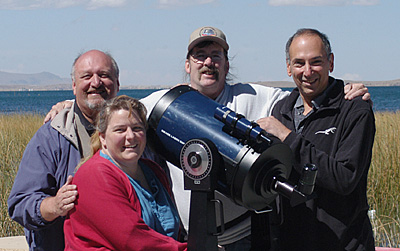 |
|
10" Meade at Southern Skies Star Party, 2004
|
The story begins back in 2004, when StarGarden Foundation owner Vic Winter and Famous Comet Hunter, David Levy spoke hypothetically about comet hunting in Bolivia; perhaps putting a remote telescope at the Southern Skies Star Party location at Lake Titicaca. David had visited the lake where he held a comet hunting workshop in August of 2005. Soon thereafter, a giant box arrived to ICSTARS and StarGarden Foundation containing a donated Meade LX-200 14" Telescope thanks to Meade Telescopes at the suggestion of David Levy.
The telescope would have a long journey before an ultimate destination at Lake Titicaca. First, it would need configured and a program generated for automated comet hunting here at the ICSTARS Ranch. Sadly, in 2007, when Vic Winter passed away, the comet hunting program's future looked grim.
Enter Fred Bruenjes in late 2007, avid astronomer extraordinaire. With his lifelong goal of discovering a comet Fred was eager to put the 14" to good use. His electrical engineering background and forte' for electro-mechanical configuration meant Fred could perform all the necessary steps to bring the telescope itself up to full speed and actually hunt for new discoveries. After dreaming of finding a comet since the age of 10 and planning for comet hunting using his own equipment, Fred was delighted to roll his sleeves up on the project and get going.
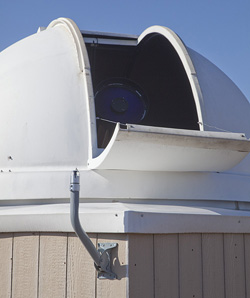 |
| Moonglow Observatory |
Fred built a new observatory with a small Exploradome and the 14" was installed into that dome specifically for the purpose of comet hunting surveys. The building was a small, basic square building only about 4' high, upon which the dome was installed. Fred wouldn't need a comfortable warm room to sit in for long nights under the stars because he had wired the observatory with high speed ethernet connection so he could run the laptop remotely from his office indoors. Once the observatory dome was up and the telescope installed, the next step would be to acquire the Starizona brand Hyperstar. The Hyperstar is designed for SCT telescopes for the unique function of reducing the focal ratio of the telescope in order to capture wide field imaging. This optical lens adapter replaces the SCT's secondary mirror on the front of the telescope reducing it to a 700mm focal length, F/2.0 instrument. Ordinarily, the light of the SCT would strike the primary, bounce off the secondary to finally be reflected back through a hole in the primary - out the back of the SCT telescope. By removing the secondary mirror, the Hyperstar now passes the light back out the front of the telescope. The camera mounts on that Hyperstar on the front end of the telescope. He chose a Canon 5D DSLR with its IR blocking filter cover slip modified because of the large chip size. Fred was now almost ready to officially hunt for comets. Fred would first need to submit a request to the International Astronomical Union's Minor Planet Center for recognition as a qualified observatory. After submission of Fred's application and observations, Moonglow Observatory was designated with IAU code H27. Now he was ready to submit any observations to the Minor planet center should he find anything.
Next Fred decided to write special search script software of his own. He already writes remote camera control software for eclipse photography with his Eclipse Orchestrator program. Now, he would add pointing controls to and a sky projection algorithm in order to select tiles of the sky and telescope movement. This special search script used what's called a 'hammer projection' which displays the entire night sky including the position of the sun and the horizon. That available sky was divided by tiles sized to the field of view of the camera as mounted on the telescope. Tiles in GREY show the part of the sky visible above the horizon. With this software, Fred can map (in RED) the areas of the sky which have been recently surveyed by larger telescope arrays; which areas are either never or rarely surveyed so that he can search areas in which his odds of a new discovery were higher. The observatory dome is not automated and doesn't move so Fred can only image in one swath of longitude at a time without moving the dome manually. Fred therefore assigns a search parameter of the area visible within the dome slit (shown in BLUE) 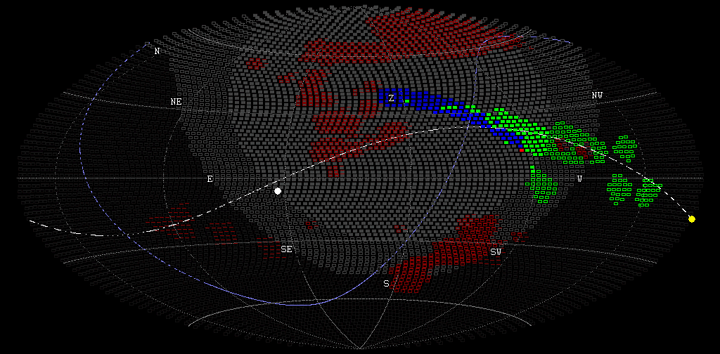 and the computer program determines where exactly to target images for that session. Comet searching is all about detecting movement between frames over time. This means that the camera must take one image, wait and take another image after a period of time and see if anything changed positions. This technique is called 'blinking'. Much like flipping pages in a cartoon book, objects that move in the sky appear to move when the images are blinked. Lots of anomalies occur when imaging, so it's always best to image at least 3 frames for better clarity on a potential moving object. In Fred's comet image control script, the program will direct the telescope and camera to capture an entire batch of images, return and take a second batch, then repeat for a third image of the full batch. We can see the blue tiles show where Fred might image tonight with the slit in this position. Green tiles show what he has already successfully imaged this week. and the computer program determines where exactly to target images for that session. Comet searching is all about detecting movement between frames over time. This means that the camera must take one image, wait and take another image after a period of time and see if anything changed positions. This technique is called 'blinking'. Much like flipping pages in a cartoon book, objects that move in the sky appear to move when the images are blinked. Lots of anomalies occur when imaging, so it's always best to image at least 3 frames for better clarity on a potential moving object. In Fred's comet image control script, the program will direct the telescope and camera to capture an entire batch of images, return and take a second batch, then repeat for a third image of the full batch. We can see the blue tiles show where Fred might image tonight with the slit in this position. Green tiles show what he has already successfully imaged this week.
Now, as of 2009 Fred was equipped, primed, qualified and ready to search. At one point, he imaged something that he suspected was a new object, but did not turn it in fast enough. Just the night before, another observer discovered the same comet Fred had, so he missed out on his first comet by 1 night's observing. He had actually shut down just one frame before the tile which contained that comet in an earlier observing session. Fred was very discouraged to know that if he had been more efficient in his searches he might have his name on a comet.
Later that year, an unlucky lightning strike to the ground near the dome would sadly short circuit the electronic PCB board within the LX200, causing a complete shutdown of the entire system. Unfortunately, as Meade had significantly downsized and moved most operations outside of the US, a simple replacement of the board was not possible. The whole scope would have to go back to the factory, with international shipping and certainly a complicated customs process. But since Fred happens to design electronic PCB boards, he chose instead to fabricate a drive board of his own. He thought, if he could design the board, perhaps he could make a number of special modifications specific to comet hunting. He spent the better part of 2010 and 2011 fabricating the board. It was quite complicated and required more than just fabricating an electronic board with pieces soldered onto it. It required actual drive programming. This meant Fred would have to spend hours out in the observatory prodding the board with the oscilloscope for test measurements and programming tweaks. Ultimately, he made some slight modifications to the method by which the motor drove to reach the designated location that caused the instrument to move much faster. Come January of 2012, the telescope was once again stable enough to image once again. Through the month of January, 2012, he performed a number of imaging sessions but was still not as satisfied with his configuration as he wanted. He was disappointed to see that the camera could not download the image while the telescope slewed to the next position. So with a few more nights' work, he worked around this limitation and succeeded. Today, the setup is capable of searching about 270 square degrees per hour to a limiting magnitude of 16. So by early February, Fred finally arrived from his long journey to a point where he could actively and efficiently comet hunt again.
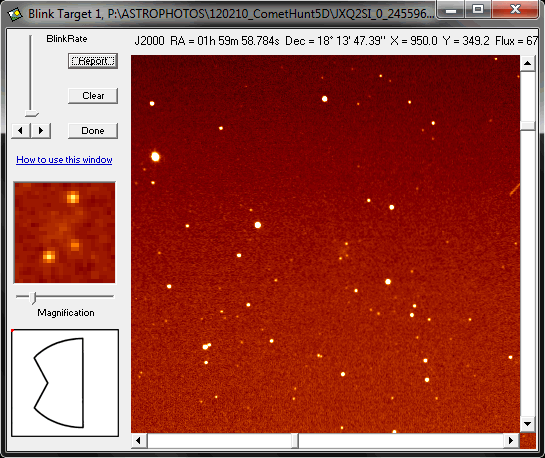 February 10, 2012. Just weeks after bringing the Moonglow Observatory comet hunting equipment up to full operating capacity, Fred was now limited only by clear skies and his need to sleep. With a clear horizon and a few hours before moonrise, the conditions were prime for amateur comet hunting. "Look West" was the age-old advice to amateur comet hunters. So Fred pointed the observatory slit west and ran his imaging routine. The camera locked up and failed to restart automatically, but Fred ran the scan again - even though the moon was rising and would soon ruin exposures. Later that evening, Fred reduced the images by blinking them in DC3's Visual Pinpoint tool. It's a 'quick and dirty' way to check for moving objects within frames. This program is great for finding pinpoint objects like Near Earth Asteroids (NEO's) but it struggles with fuzzy objects like comets. So Fred took some extra time to visually look at the files in the blink sequence. This is when he noticed a faint, fuzzy object moving from right to left in 3 frames in what appeared to be a very strait line. Fred checked and found no known comets or objects of any kind in this approximate latitude or longitude. While this news was promising, Fred was still very skeptical that it could be what he hoped. Later that night, Jen returned from out of town and the two reviewed the images together. Jen had imaged more comets than Fred through ICSTARS and immediately asserted that it appeared comet-like in color and shape. The color corrected image was aqua-blue in hue; a common color for comets due to cyanogen and carbon emission. The smudge in the images was beginning to 'smell like a comet'. However, both Fred and Jen were still concerned about a number of factors which must be ruled out. The apparent movement of this comet was odd. Typically, comets move in the opposite direction than this was moving. The fact that the moon was up was also concerning. Often internal reflections within the telescope from bright objects can cause light patches which move in strait lines. The planet Jupiter was just 6° away from the object, so its bright light could be causing the reflection. This is why the standard procedure for verification of comets must include observing on a second night. The scan area had already set, so there was nothing to do but wait until the next night to confirm the position of the object. A very very long night and day passed before Fred could open the observatory and image again. In the meantime, he was able to roughly calculate the new position of the comet mathematically. He hoped that he might calculate the position, point the telescope to that spot the next night and miraculously click the shutter to see it in the centered in this precise location the next night. February 10, 2012. Just weeks after bringing the Moonglow Observatory comet hunting equipment up to full operating capacity, Fred was now limited only by clear skies and his need to sleep. With a clear horizon and a few hours before moonrise, the conditions were prime for amateur comet hunting. "Look West" was the age-old advice to amateur comet hunters. So Fred pointed the observatory slit west and ran his imaging routine. The camera locked up and failed to restart automatically, but Fred ran the scan again - even though the moon was rising and would soon ruin exposures. Later that evening, Fred reduced the images by blinking them in DC3's Visual Pinpoint tool. It's a 'quick and dirty' way to check for moving objects within frames. This program is great for finding pinpoint objects like Near Earth Asteroids (NEO's) but it struggles with fuzzy objects like comets. So Fred took some extra time to visually look at the files in the blink sequence. This is when he noticed a faint, fuzzy object moving from right to left in 3 frames in what appeared to be a very strait line. Fred checked and found no known comets or objects of any kind in this approximate latitude or longitude. While this news was promising, Fred was still very skeptical that it could be what he hoped. Later that night, Jen returned from out of town and the two reviewed the images together. Jen had imaged more comets than Fred through ICSTARS and immediately asserted that it appeared comet-like in color and shape. The color corrected image was aqua-blue in hue; a common color for comets due to cyanogen and carbon emission. The smudge in the images was beginning to 'smell like a comet'. However, both Fred and Jen were still concerned about a number of factors which must be ruled out. The apparent movement of this comet was odd. Typically, comets move in the opposite direction than this was moving. The fact that the moon was up was also concerning. Often internal reflections within the telescope from bright objects can cause light patches which move in strait lines. The planet Jupiter was just 6° away from the object, so its bright light could be causing the reflection. This is why the standard procedure for verification of comets must include observing on a second night. The scan area had already set, so there was nothing to do but wait until the next night to confirm the position of the object. A very very long night and day passed before Fred could open the observatory and image again. In the meantime, he was able to roughly calculate the new position of the comet mathematically. He hoped that he might calculate the position, point the telescope to that spot the next night and miraculously click the shutter to see it in the centered in this precise location the next night.
|
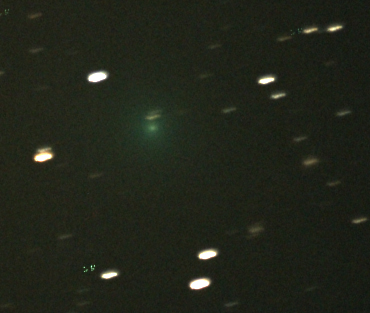 |
|
9 stacked images of Comet C/2012 C2 (BRUENJES)
|
That is exactly what happened. As twilight slowly faded on February 11, 2012, Fred began to hammer the area in question. Sure enough, the elusive smudge appeared just as if on command. Fred would spend the next hour capturing more images to submit to the minor planet center for his report. With luck, the observations would be clear enough to qualify his observations to put on the IAU Minor Planet Center's confirmation page. The confirmation page is where observatories worldwide can perform follow-up. The object was given the designation T0003C and posted within a few minutes to the Minor Planet Center confirmation page. After completing his formal submission, Fred took some time to stack images for a composite. First, he stacked 9 images, then 19 images in 2 different composites which center on the comet, which show the surrounding stars streaking by; with the comet holding still. By morning, the Minor Planet Center had contacted Fred to inquire about his full legal name; and soon thereafter some 50 different indepenent observations had been made. At 21:14 UT, the Minor Planet Center issued the bulletin MPEC 2012-C44 : COMET C/2012 C2 (BRUENJES), naming the object as a comet and naming it after discoverer, Fred Bruenjes. |
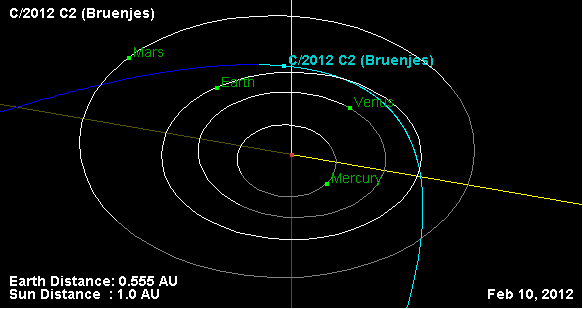 Much has been learned about Comet C/2012 C2 (Bruenjes) since its discovery. We know that the comet was actually discovered AFTER passing its closest approach to planet Earth. At the time of its discovery, Comet Bruenjes was actually between Earth and the planet Venus on its way in around the Sun. The comet, at its closest earth distance was 0.555 AU, that is to say that Comet Bruenjes came just over 1/2 the distance between the earth and the sun - away from our planet. It also comes extremely close to earth's orbit itself. In its path in, Comet Bruenjes passes just 0.052AU away from the actual path of Earth's orbit. Fortunately, the earth was not in position at that time to be at high risk. Objects within 0.05AU are considered to be at risk as Near Earth Objects. Much has been learned about Comet C/2012 C2 (Bruenjes) since its discovery. We know that the comet was actually discovered AFTER passing its closest approach to planet Earth. At the time of its discovery, Comet Bruenjes was actually between Earth and the planet Venus on its way in around the Sun. The comet, at its closest earth distance was 0.555 AU, that is to say that Comet Bruenjes came just over 1/2 the distance between the earth and the sun - away from our planet. It also comes extremely close to earth's orbit itself. In its path in, Comet Bruenjes passes just 0.052AU away from the actual path of Earth's orbit. Fortunately, the earth was not in position at that time to be at high risk. Objects within 0.05AU are considered to be at risk as Near Earth Objects.
The comet was estimated at about 15th magnitude at the time of its discovery and because it is continuing to move away from earth, it is getting dimmer and dimmer every day. It will leave the solar system on a course that does not come close to earth's orbit, so it will not be brighter than it is now at any time on this orbital visit to the center of our solar system. The comet's approach to the Sun is close enough that we must observer it again after it passes by the Sun to be sure of its ultimate orbit. Only then can it be determined whether it might return again.
Ephemerides for the comet can be found in common Astronomical positioning programs.
Additional information about the comet can be found on the IAU Minor Planet Center electronic Bulletin MPEC 2012-C44
|
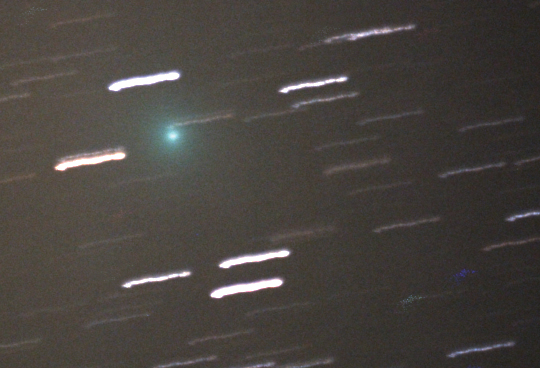
 Much has been learned about Comet C/2012 C2 (Bruenjes) since its discovery. We know that the comet was actually discovered AFTER passing its closest approach to planet Earth. At the time of its discovery, Comet Bruenjes was actually between Earth and the planet Venus on its way in around the Sun. The comet, at its closest earth distance was 0.555 AU, that is to say that Comet Bruenjes came just over 1/2 the distance between the earth and the sun - away from our planet. It also comes extremely close to earth's orbit itself. In its path in, Comet Bruenjes passes just 0.052AU away from the actual path of Earth's orbit. Fortunately, the earth was not in position at that time to be at high risk. Objects within 0.05AU are considered to be at risk as Near Earth Objects.
Much has been learned about Comet C/2012 C2 (Bruenjes) since its discovery. We know that the comet was actually discovered AFTER passing its closest approach to planet Earth. At the time of its discovery, Comet Bruenjes was actually between Earth and the planet Venus on its way in around the Sun. The comet, at its closest earth distance was 0.555 AU, that is to say that Comet Bruenjes came just over 1/2 the distance between the earth and the sun - away from our planet. It also comes extremely close to earth's orbit itself. In its path in, Comet Bruenjes passes just 0.052AU away from the actual path of Earth's orbit. Fortunately, the earth was not in position at that time to be at high risk. Objects within 0.05AU are considered to be at risk as Near Earth Objects.

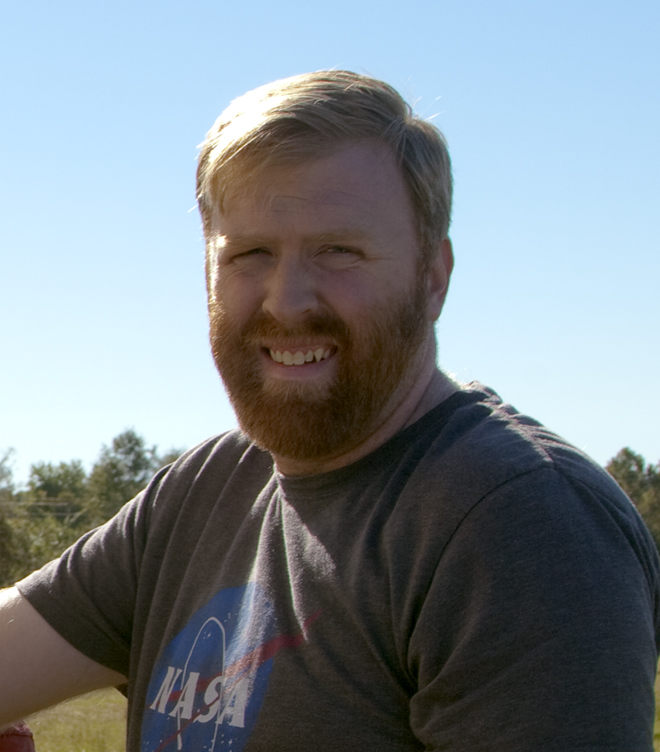


 and the computer program determines where exactly to target images for that session. Comet searching is all about detecting movement between frames over time. This means that the camera must take one image, wait and take another image after a period of time and see if anything changed positions. This technique is called 'blinking'. Much like flipping pages in a cartoon book, objects that move in the sky appear to move when the images are blinked. Lots of anomalies occur when imaging, so it's always best to image at least 3 frames for better clarity on a potential moving object. In Fred's comet image control script, the program will direct the telescope and camera to capture an entire batch of images, return and take a second batch, then repeat for a third image of the full batch. We can see the blue tiles show where Fred might image tonight with the slit in this position. Green tiles show what he has already successfully imaged this week.
and the computer program determines where exactly to target images for that session. Comet searching is all about detecting movement between frames over time. This means that the camera must take one image, wait and take another image after a period of time and see if anything changed positions. This technique is called 'blinking'. Much like flipping pages in a cartoon book, objects that move in the sky appear to move when the images are blinked. Lots of anomalies occur when imaging, so it's always best to image at least 3 frames for better clarity on a potential moving object. In Fred's comet image control script, the program will direct the telescope and camera to capture an entire batch of images, return and take a second batch, then repeat for a third image of the full batch. We can see the blue tiles show where Fred might image tonight with the slit in this position. Green tiles show what he has already successfully imaged this week.  February 10, 2012. Just weeks after bringing the Moonglow Observatory comet hunting equipment up to full operating capacity, Fred was now limited only by clear skies and his need to sleep. With a clear horizon and a few hours before moonrise, the conditions were prime for amateur comet hunting. "Look West" was the age-old advice to amateur comet hunters. So Fred pointed the observatory slit west and ran his imaging routine. The camera locked up and failed to restart automatically, but Fred ran the scan again - even though the moon was rising and would soon ruin exposures. Later that evening, Fred reduced the images by blinking them in
February 10, 2012. Just weeks after bringing the Moonglow Observatory comet hunting equipment up to full operating capacity, Fred was now limited only by clear skies and his need to sleep. With a clear horizon and a few hours before moonrise, the conditions were prime for amateur comet hunting. "Look West" was the age-old advice to amateur comet hunters. So Fred pointed the observatory slit west and ran his imaging routine. The camera locked up and failed to restart automatically, but Fred ran the scan again - even though the moon was rising and would soon ruin exposures. Later that evening, Fred reduced the images by blinking them in 